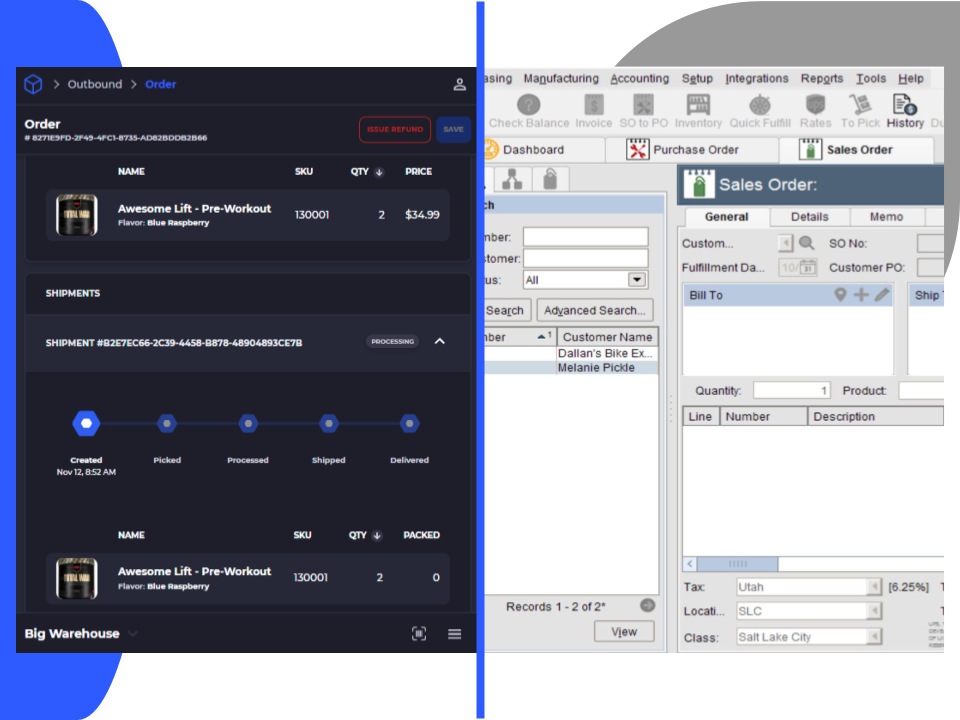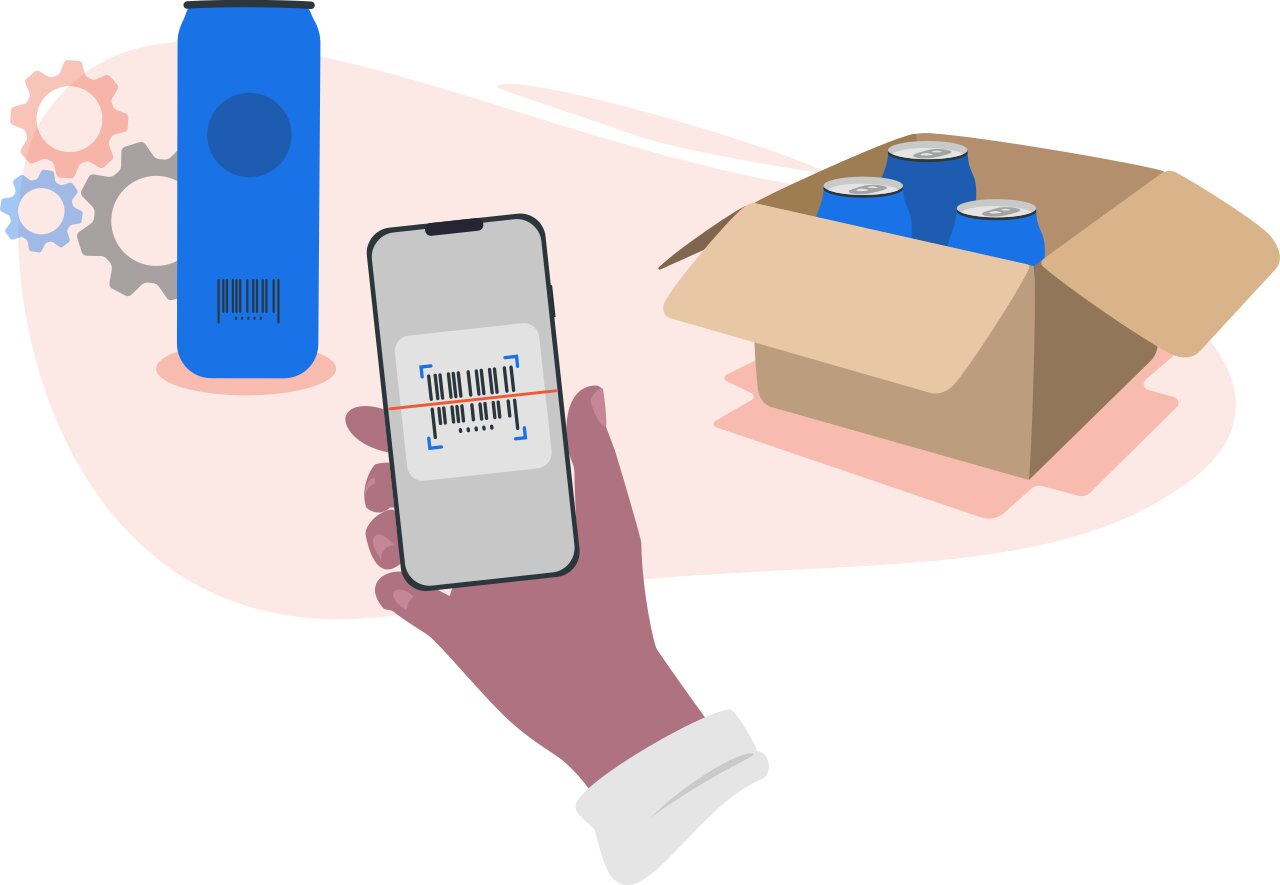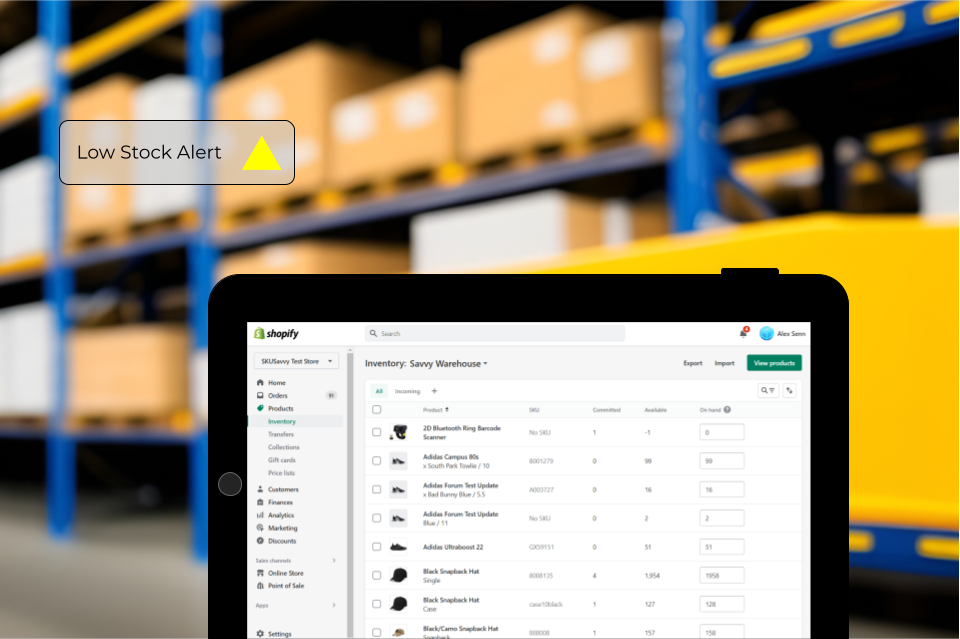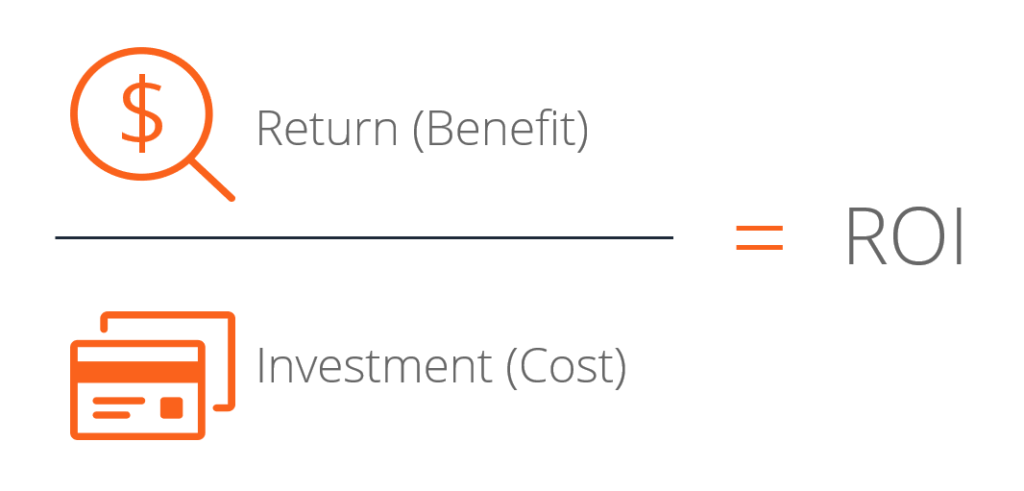Best Shopify Inventory Management Apps + Comparison Guide
Alex
3/4/2022
Similar Posts
Which App is Best for Shopify Inventory Management?
Shopify stores are quickly becoming the defacto standard for eCommerce websites across the web. Many scale incredibly quickly, and inevitably come to the conclusion there must be a Shopify inventory management app that can help them fulfill orders easier. If this is your current situation, or you anticipate this happening soon, you're in luck. With Shopify's robust app marketplace and open APIs, there are many options for you to get a system in place which will help relieve the pressure of fast-paced order fulfillment. Though there are many different inventory systems out there, the key is to find something that will fit your particular storage, fulfillment, and shipping needs. The needs of an eCommerce merchant running 15,000 orders per month and one running 150,000 are quite different so this breakdown will organize the inventory management apps by volume. Something that can also throw a loop into the fulfillment process is your product assortment (SKU Count), kitting or bundled products, manufactured items, and perishable products. All these factors involve more planning and requirements from any particular inventory management system. So, to address this, the inventory management apps will also be sorted by top categories including apparel and fashion, food and perishables, business supplies (B2B), and consumer goods. The selection criteria for these platforms are important, so let's take a look at some key features and benefits to compare with.
What Key Benefits and Features Should You Look For
When evaluating different inventory systems for Shopify it's helpful to put together a list of your own requirements and expectations. Consider the way you currently fulfill orders, and what you'd like to see in the future of your business. Identify challenge points now and aggregate these in the form of questions to be asked of the team behind the inventory management app. Consider what the system will need to perform for your product set. Do you need kitting, bin assortment, multiple order streams, specialized shipping, or multi-stage order fulfillment? These are all good things to build up questions on. Here's a few important ones:
Benefits to Expect
Improved Order Throughput
Improved Order Accuracy
Faster Time To Ship
Inventory Visibility
Quick Inventory Action
Time Savings
Higher Profit Margin
Easier Business Management
Features to Look For
Sync Data from Shopify: customers, orders, inventory, vendors
Purchase Order Sync
Inbound Inventory Tracking
Inventory Location Tracking
Lot and Expiration Tracking
Inventory Barcoding
Inventory Control System
Inventory Replenishment
Inventory Relationship Tracking
Inventory Rule Automation
Inventory Reporting
Inventory Optimization
Pick Pack Ship
Inventory Order Batching
Shopify Store Size
Starter Shopify store
Up to $1,000,000 Annually
100-500 Orders Daily
Single Warehouse
Limited SKU Count
Growing Shopify Store
$1M-$5M Annually
500-5000 Orders Daily
Large or Multi-Warehouse
Large SKU Count
Plus-Sized Shopify Store
$5M-$50M+ Annually
5,000-25,000 Orders Daily
Multi Warehouse + 3PL
Large & Complex SKU
In this lineup, we are actually considering many of the competing software to SKUSavvy. Before we even started building SKUSavvy we had already evaluated over 30 different software options out there. We had used several other systems before and determined we could do it better. We didn't find anything modern and mobile was almost nonexistent. We wanted to create something that would go way beyond the classic inventory management or warehouse system app. In fact, we incorporated features such as a visual warehouse layout, visual picking, visual packaging, and an integrated platform network to start. But, that wasn't where we stopped. We knew that there really wasn't a leading mobile-based warehouse and inventory management system out there. We stepped in and enabled SKUSavvy to handle all the essential components: purchasing automation, receiving, put-away allocation of inventory, inventory control, order management, multichannel order sync, visual pick routing, barcode scanning via any iOS or Android device as well as in the browser (first of its kind), visual packaging, mobile shipping label validation, rate shopping, and label purchase, returns, and real-time order sync across multiple warehouses. In essence, it's built to be the best across a variety of store sizes, channels, and industries.
Your First SKUSavvy Account Is Free
Automated Purchasing
Directed Put-Away
Inventory Control
Order Management
Multichannel Management
Pick-Pack-Ship
100% Mobile Ready Interface
Mobile Barcode Scanning
Mobile Printing
Multi-Warehouse
Network Trading
Order Batching
Automated Bin Replenishment
Detailed Employee Permissions
Real-time Data Sync
Starter Shopify Inventory Mangement Apps
Meant to serve companies who are just getting to the point of needing an inventory management system because Shopify is no longer providing enough in the way of order management and warehouse management to keep up. These Shopify inventory management apps are typically going to be within the range of $39-$200 per user per month, or they will have a capped initial setup fee and then a base monthly fee after that. Many of these companies are direct competitors to SKUSavvy, and some offer different advantages, but all were considered before we built SKUSavvy, so we knew what you'd need to run your store.
Veeqo
The Good
Offers connection to multiple channels
Good shipping service options for UK, and overall a good entry system in UK
App for picking functions
Warehouse activity coordination
Automations for shipment priority
Good for beginning stores
The bad
Very limited mobile app
Pricey for an introductory software
Will not handle a complex inventory assortment
Can easily outgrow the solution with order management strangleholds
Limited market availability
Limited WMS capacity
vEEQO pRICING
At 5,000 Orders and 5 users per month:
BASE: $338/month + $40/user/month after 6 users
MID: $513/month + $40/user/month after 8 users
TOP: $916/month + $40/user/month after 9 users

Listed as the inventory and shipping platform for eCommerce Veeqo positions itself as an omnichannel suite of tools to manage inventory across your eCommerce channels. A UK-based company, Veeqo has a sleek UI with all the features necessary to track inventory, make adjustments for orders, allocate inventory, pick, pack, and ship. They currently offer 21 different shipping couriers and have built-in tools for order routing automation to send orders to the right carrier based on conditions. On the purchasing side Veeqo offers tools to create POs and send them to vendors, allows for multiple costs across different vendors, and will enable mobile check-in of inventory. This platform has a mobile application that will allow you to handle picking and packaging, though the mobile warehouse layout and picking are relatively limited with that else you can do. The mobile application will allow for various print jobs to handle shipping labels, bin labels, invoices, packing slips, and a variety of other labels. For those with complicated items Veeqo may lack some of the granular details for storage and retrieval you need, however for simple SKUs it's a good all-around, simple option for starting out. They offer many different integrations with top eCommerce and shipping providers which will make it easy to connect your orders, customers, and inventory. There is again limited functionality when it comes to placing orders directly within Veeqo, or for field sales channels. For any company doing wholesale orders, this may not provide the cross-product relationships needed to manage pallet, case, or single items, though they do offer variations for size, color, texture etc.
ShipHero
The Good
Offers a Shopify app
Simple interface control which limits the complexity
Multi-channel compatibility (10+ channels)
Bulk shipping for streamlined labels
Lot and Expiration
The Bad
Pricey for mid-stage eCommerce brands and may not include everything needed
Limited mobile app capability
Hardware required
Support is hard to get ahold of based on some reviews
Simple product set
ShipHero Pricing
BASE: $1,850/month + $30 per store connection after 10 + $150 per user/month after 5 users
3PL: $1,995/month + $30 per store connection after 10 + $150 per user/month after 5 users

Using ShipHero as a Shopify Inventory management app does pave the way for an introductory system, though at a higher price than you might be looking to pay. The ShipHero platform provides a simple way to manage your inventory and track orders. They are also a 3PL company, so you can send inventory to them to manage, though some of their reviews notes this may be taking away from the help given toward running the software. If you need a pretty piece of software that is running in a cloud environment at a premium price this is the software. The advantage of ShipHero is that they are listed on the Shopify app store. They have two different packages for either D2C brands or 3PL software package. The pricing for less functionality, when compared to SKUSavvy, is over $1,000 more expensive at 5 users, and is $1,850 more expensive at a single user. So, while they do have some good and simple software you'll need to determine if the cost compared with the feature set is something you'll be able to afford. On the plus side, the mobile capabilities within ShipHero while limited on the administration/reporting make for a decent tool for your employees to use to handle cycle counting, picking, and barcode scanning. To compare, the SKUSavvy app limits functionality based on the role of the employee, but everything is made with the mobile user in mind to use 100% of the platform via any mobile device.
OrderHive
The Good
One of the cheapest options on the list with a free first user account
Decent tracking of orders from the time placed all the way through fulfillment
Extensive feature set
Admin tools extensive at the right user level
The Bad
unfortunately there are quite a few recent bad reviews on this software
Very buggy - with so many features this is almost unavoidable
Limited or no mobile capability
Slightly more complex user interface
Orderhive pricing
Free: limited to Shopify and 1 user at <200 orders
Lite: $45/month for 1 user + $50/month/user extra + $0.30 per order over 200 orders
Starter: $135/month w/ 3 users and 1200 orders + $50/user/month over 3 users, $0.15 per order over 1200 orders
Growth: $269/month w 5 users and 3000 orders + $50/user/month over 5 users + $0.12 per order over 3000 orders

Coming in as one of the cheapest options in our comparison of different apps to run your Shopify store with is OrderHive. This extensive platform will likely have all the various features you would need to run a store. While it may not be a super mobile or introductory platform operationally, there are a lot of options within the platform to handle unique situations. The price is one reason many have utilized the platform. However, if you look through some of the reviews, one recently in May 2021 mentioned the terrible issues they had with bugs throughout the system. of course managing such a robust feature set get's complicated, and its likely you won't need to use many of the functionalities available. When compared with SKUSavvy this system may have more capability. From our own analysis of OrderHive though, SKUSavvy is considerably easier to use with automation just happens without having to get the settings just right. The lack of mobile capability is really a dissapointment. Additionally, if you are doing high volume, there is a real worry for merchants that may find their OrderHive bill significantly larger due to their per order charges and additional charges for users. Something else to be careful of when getting signed up here is the limited plans available. For each plan there is a new segment of features opened up. So, be sure not to get caught where you are expecting something but find out it will require the next level up to get that.
TradeGecko/Quickbooks Commerce
The Good
Wholly owned by QuickBooks so the integration with QB is solid if you are already tapped in
B2B store capability
SImplified multi-channel management
Mobile sales app
Intro pricing
The Bad
Limited warehouse level detail of product bin and storage levels
Order fulfillment app only available in the enterprise version
Limited replenishment capability and fulfillment processing
TradeGecko/QuickBooks Commerce Pricing
Starts at $39/month for <10 orders/month and 1 user
Lite: $99/month for <50 orders/month and 2 users
Small Biz: $249/month with <500 orders/month and 5 users
Business: $799/month with 8 users and <5000 orders

Tradegecko, now Quickbooks Commerce is the warehouse and fulfillment service of Intuit. If you've already been initiated to Quickbooks this might be your solution. Since the platform is owned by Quickbooks data flows between the two seamlessly. This extension to the Quickbooks ecosystem is made for small businesses with only a limited number of orders. The limits across various price tiers are quite small and will mean you end up paying unexpectedly for any sort of sales spike or hiring spree. This system is strong with its various channel connections with Shopify, WooCommerce, and others. With these channels, there may be added fees and premium vs. free pricing for the integration. While looking through the website QB Commerce does offer a mobile sales app to manage new sales orders from wholesale or store sales if this is helpful. The sales app does help with order updates and live order placement but does not offer anything on the fulfillment side. While the platform will help you with the warehouse and bin location management at the enterprise plan, it does not handle bin placement and allocation of inventory on the entry plan. They providing a variety of shipping options to ship inventory directly on behalf of most of your channels and through 3PLs. All in all, it's a good entry system that will add up over time. Best suited for companies with a less complicated product set and not requiring a huge volume of shipments daily.
Finally a Modern Mobile Inventory Management System for Shopify
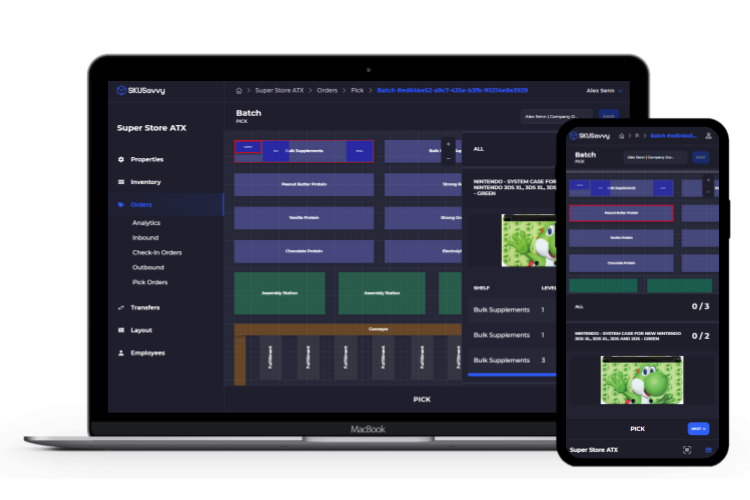
Growing Shopify Inventory Management Apps
The next category of Shopify inventory management apps is meant for higher volume storefronts. There may be some overlap, and some of these systems could probably satisfy multiple order volumes, but in my search, these seem to be the best options. Searching for a system that will handle what you need it to at your level of growth is tricky. While growing you have different challenges. So these apps will help with inventory and bin placement, replenishment, and purchase orders, as well as automating the fulfillment systems and shipment routing. Generally made for shops doing over 1000 orders a day these systems compare best with SKUSavvy from a functionality perspective. What's key to look for here is the automation and warehouse management information. Fulfilling 1000+ orders a day begins to require more on the inventory management, reordering, and replenishment of bins along with other operations beyond just the picking and shipping.
SKUVault
The Good
Timely customer support through several channels
Replenishment and purchase order simplicity
Multi-channel and multi-warehouse capability across products, channels, and brands
Lite manufacturing & bin assignment
The Bad
No mobile app, must rely on the stock software
Sync times between channels can be slow and often at inconvenient times
Pick scanning slow, repetitive, and clunky
Expensive and large product requiring large teams
SKUvault pricing
Growth: $299/month + $125/month/user over 2 users with <2000 orders/month
Pro: $449/month + $100/month/user over 2 users with <5000 orders/month
Enterprise: $899/month + $75/user/month over 2 users with <20,000 orders/month

The first entry into a larger format Shopify inventory management app solution. SKUVault has many of the features you'd expect within a fully featured warehouse management system. The advantages here come with scalability. Since this product is fully built out, you will expect to utilize at least ten employees to fully make use of the capabilities within the system. The limitation with that is when we look at how much utilization you are making of the software suite. Does it require you to have all those features in there that you are already paying for? If yes, then you know the cost can be justified. SKUvault has been built over a long time and thus has a more early 2000s software feel to it. This may prove over time to be a downside as innovation in the supply chain comes faster with robotics and automation. One cool aspect of SKUVault, that the team at SKUSavvy has also been working on is the network. SKUVault network helps to discover new vendors and retailers but fails to allow payments directly to be exchanged like SKUSavvy. With this system in place, you do have the advantage of many different channel offers which can allow you to get up and running quickly across multiple platforms while handling all your inventory in-house.
Odoo
The good
Open source for full customization
Apps for every business facet across multiple industries
Robust reporting suite
Customization of workflow via Odoo studio
The bad
Very large product/suite of tools and may be to large to operate for your team
No mobile app
Require laptops and mobile stations for printing
Integrations are typically paid, and pricey ($499/month
Odoo Pricing
Starts at $84/month for one user with no onboarding, and no Shopify
Shopify connection is $484

For open-source software, Odoo does have quite a range of products. It is regarded as an ERP, so you may find apps for every aspect of your business. Most relevant here is their inventory management app. While it is not a fully-fledged warehouse management system, there is plenty of functionality for small and medium-sized storefronts. This is great but will require a good amount of resources to manage the whole product. Odoo is a slightly complicated product to get used to and so it may well require training which will be purchased from Odoo directly. Another thing we didn't like is that each app is paid for separately, and is charged per user. But, the most significant difference here is that to connect your Shopify store, you will rely on a 3rd party app. This app is $499 to start and the first impression is that it may not provide everything you are looking for within the scope of modern fulfillment capability.
Fishbowl Inventory
The Good
A plethora of features for manufacturing, inventory, and warehouse management
Enables materials requirements, manufacturing and production, job shop floor control
Good support
Expensive and mobile is a whole separate product to buy
May offer lots of features outside of what's needed
Very outdated product tech stack, and older 'Windows' style interface which must be downloaded
Fishbowl Inventory Pricing
$4,395 per perpetual license
Requires applications for mobile capacity and advanced purchasing/allocation, pick, pack, pick
Handhelds start at $895, printers start at $600

One of the older more established companies in the inventory management space. Still within the small to medium-sized enterprise size. With such a long time in the field, you can find nearly anything you could imagine from inventory to manufacturing, purchasing, and replenishment. That said, it's both a blessing and a curse since much of the negative feedback on Fishbowl is the outdated interface and slow loading time.. For well-established companies that may have legacy system requirements, this might serve you well. Fishbowl is offered as an on-premise solution though they have recently released Fishbowl online to contend with other cloud offerings. We did not like that some of the major components (Fishbowl Go for instance) require a whole separate subscription license. This may make things expensive overall, especially considering the up-front cost is high here. For companies making their own product on-premise, requiring light manufacturing and production tracking, you will be able to make good use of these tools provided within the base version of Fishbowl.
Zoho Inventory
The Good
A large suite of tools for business and operations beyond inventory
Good if already tapped into the Zoho suite
Mobile inventory and pick-pack-ship app
Multi-channel, multi-warehouse capable
The bad
Does not support bin placement and storage retrieval
No pick route planner
Limits order number/warehouses based on subscription
Limited mobile app capability
Zoho Inventory Pricing
Free for 1 warehouse, <50 orders, 2 users
Standard: $79/month, <1500 orders/labels/month, 2 warehouses, 3 users
Professional: $129/month, <7500 orders/labels/month, 5 warehouses, 5 users
Premium: $199/month, <15000 orders/labels/month, 7 warehouses, 10 users
Elite: $299/month, unlimited orders, 15 warehouses, 15 users

Similar in some ways to Odoo the Zoho suite of tools can cover every part of your business from accounting to finance, collaboration and messaging, invoicing, and time tracking. Their Zoho inventory platform is specifically what we are comparing here. Zoho offers all the base features you might expect to store products, connect order channels, and fulfill orders. There is a drawback in that we didn't find specific location information for the warehouse bins. It does appear to allow multiple connections to different channels, and allow you to fulfill those orders across your various warehouses. Zoho will give you the option to automate some of your workflows. Shipping service selection and reorder levels are automated but there are still many manual tasks you will have to assign. For a small and growing company that doesn't have a complicated product set, and who has the right team size to support the Zoho suite, it is a good entry-level system. We did find their mobile app seems modern, but it does not allow you to control the entirety of your warehouse capability. Instead focusing on the orders themselves and packaging of the orders for fulfillment. Select companies might find this platform useful for their needs.
Plus-Sized Shopify Inventory Management Apps
When you get to a certain size Shopify storefront, the operations and logistics portion of your entire operation become increasingly more complex and time-consuming. For this reason, the systems you choose to employ will have a significant impact on how efficient you can be. In this category, we are including a few enterprise-level systems that certainly might be overpriced for some, but for others, it'll be exactly what you need. Find things like slotting, automated warehouse allocations, EDI connections, accounting tools, and more. With the time required to transition from one system to another, it's worth the investment of time and money to identify which solution will solve your needs the best. If growth is fast enough, you'd be wise to consider going one step ahead of where you feel you are (if budget allows) with the intent of 'growing' into the solution. Our solution, SKUSavvy, does have many of the enterprise-level capabilities, without the complex settings and modules that come with most enterprise-class WMS.
3PL Central/Skubana
The Good
Built for 3PL providers, with functionality to handle most warehouse channel connections
Additional features for billing and warehouse automation with AGV and sortation hardware
Strong EDI and API connections for customized workflows
The bad
Recently acquired Skubana so the features are not fully integrated yet
Purpose-built for 3PL and may not have eCommerce fulfillment features needed
Mobile capability is sold separately and limited fulfillment capability
Among the most expensive tier-II systems
3PL Central/Skubana Inventory Pricing
Custom to each business based on a number of variables like which products you need, how many orders/users you have
$$

The go-to solution for 3rd party logistics providers who have not graduated to a tier-one system. You can expect everything you'd need to handle the warehouse and/or 3rd party logistics services to be included here. If you are not providing 3rd party logistics, it's unlikely you will need to use the whole suite of products. However, 3pl Central has recently bought Skubana which is an enhanced WMS. It's not clear how the two will integrate, but you can be sure if you are not using the 3pl services, you will likely be using the Skubana platform under the hood. One thing to be cautious about using 3PL Central is they have multiple different products, and they charge separately for each of these systems. To handle eCommerce fulfillment for a fast-growing storefront, you will need each of these services aside from the billing portal for 3pl services. In the case you are doing 1,000+ orders a day, this platform may be a solid solution for you, and it should be considered.
Brightpearl
The Good
Omnichannel to provide resources for online stores, retail stores, and wholesale stores
POS system for retailers
Integrated tools to move inventory across the supply chain
Includes ERP and CRM functionality
The bad
Requires a large workforce to operate the platform with so many features
Required extensive training
Limited mobile capacity for inventory management, pick-pack-ship
Expensive tier-two system
BrightPearl Inventory Pricing
Custom to each business based on a number of variables like which products you need, how many orders/users you have
$$

One of the longest-standing inventory, warehouse, and purchase order management platforms. Cin7 is a cloud-based platform that like Brightpearl offers the full spectrum of retail, wholesale, and D2C tools to facilitate each of your channels and mediums. The system is designed to work with one of three different types of hardware scanners. The full scope of this platform covers inventory/warehouse/order management, B2B online stores, EDI, integrations, reports & forecasting, POS, payment portal, production management, sales quoting, and 3PL. This is a significant amount of capability covered and again here you need to confirm that in fact you will have enough people to properly run this system. With the integrations and integrated approach to each core component, an omnichannel company might need you will most likely find your challenge covered here. The cautions come when looking at the complexity of the product, the support time necessary to get answers, and the pricing of both software and hardware to cover your team. It is an investment and a big one at that. This type of platform is really meant for 2000+ orders daily across a network of retail stores and distribution centers.
Cin7
The Good
Built-in EDI, WMS, POS, and production management workflows
Large enterprise-grade product and pricing
Largest selection of integrations
Helpful implementation and setup training
The bad
Potentially waiting more than a week (sometimes months) to resolve issues
Pricing is based on the number of connections and each type of integration/market will be charged separately - tricky expensive pricing
Large volumes of orders may be slow to sync up
Cin7 Pricing
Custom to each business based on a number of variables like which products you need, how many orders/users you have
$$

Labelled as the omnichannel retail operating system, this is one of the most robust systems for the retail operations category. You have the ability to connect multiple channels and deal with them independently if needed. One of the unique advantages here is the enterprise resource planning tools as well as their customer relationship management system built it. While many companies may already be using another system it is nice to have everything placed into one dynamic solution. One of the biggest challenges users face is that A) they cannot use the product because it is too big and B) they are not getting sufficient support in a timely manner C) the dashboards are not very customizable and leave out information. All that said, there are other integrations you can connect to Brightpearl to get this desired functionality. Another area Brightpearl lacks in is the warehouse for mobile pick-pack-ship and it's where we suggest you connect with a true WMS enabled inventory management app like SKUSavvy. if cost is a major factor and you will not be using much of Brightpearl's functionality, it's best to step down to a system that gives you nearly as much without the same cost.
Finale Inventory
The Good
Capable of high-volume multichannel inventory management
Flexible enough to meet unique inventory needs
Robust reporting dashboard
The bad
Barcode scanning uses a really basic Android app requiring Zebra scanners which other users complained about being slow
Complicated UI and not adapted for mobile usage, buggy when loading between screens
Finale Inventory Pricing
Starter: $75/month with 1 user and 2 integrations, <500 orders/month, limited functionality
Bronze: $199/month, 4 users, <2000 orders, 4 integrations
Silver: $349/month, 7 users, <5000 orders, 7 integrations
Gold: $549/month, 11 users, <10000 orders, 11 integrations
Platinum: $799/month, 16 users, <20000 orders, unlimited integrations

Perhaps the most cost-competitive of the plus-sized Shopify inventory apps. Finale Inventory is more than just a Shopify inventory management app in that they will handle light manufacturing, inventory control and multi-warehouse management, serial and lot tracking, order management, purchasing &replenishment, barcode scanning, order pick-pack-ship, and kitting/bundling. We did not find much of a mobile application, and the one we did find will still require expensive hardware from Zebra that looks outdated, it seems to do the job for now. Unlike many of the other platforms, Finale seems to provide good customer service. Like many of the other systems, this is a large platform and demands that you have a big enough business to justify the large feature set. One thing with their pricing is that with the functionality they offer and the number of accounts it's likely you'll need extra seats to support your whole team and the usage of the system. On this note some users found the user permissions lacking which meant team members had more permissions than they should have. Splitting inventory and maintaining multiple warehouses was not easily accomplished some users complained about. Overall one of the most cost-competitive solutions compared to the other systems in this tier.
There you have it, an updated review on all the relevant Shopify inventory management apps out there. Of course, at a certain size, you might start looking at a Netsuite, Microsoft Dynamics, or SAP-based system, but that is for the largest of enterprises and outside the scope of this particular comparison. If you've got some feedback or want to provide your own accord of any system listed here we'd love to hear from you. We might be biased here but the SKUSavvy platform is newer, faster, and better than any of these systems listed above. That's an objective fact since we built this platform with the shortcomings of the other systems in mind. That said, we hope you will consider giving SKUSavvy a try, after all, it's free for 50 orders/month then just $0.19-$0.04/order so there really isn't much to lose. Cheers!

